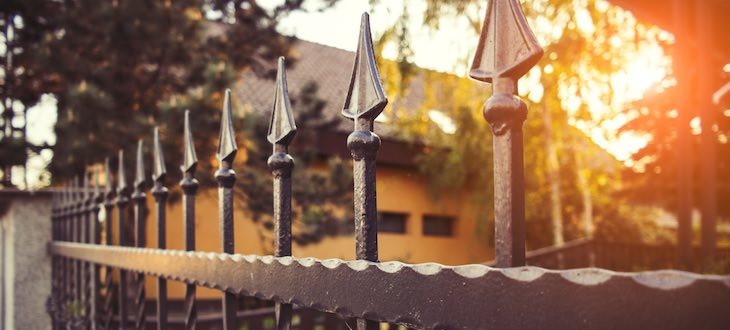When you are researching fences, stairs, handrails, and balconies especially in the Historic City of Ybor in Tampa, Florida, you have heard of ornamental iron and wrought iron. Most people think these terms are interchangeable. Typically, they are referring to one of three things:
- Hand forged items in general
- Actual wrought iron
- The “look” of wrought iron
We will try to clear up the confusion by discussing ornamental iron pros, wrought iron pros, and ornamental iron wrought iron differences.
What is Ornamental Iron?
Ornamental iron is a decorative element that is available in many styles. It is used in fences, gates, handrails, and patio furniture. It is virtually weatherproof and makes an attractive building material. Home designers will often incorporate iron embellishments in the renovation of a vintage residence, both for security and for a look of refinement. When used as a decoration, ornamental iron can be very stately and elegant.
Ornamental iron options include shaped bars and sheets, pickets, rings, rosettes, stamped floral designs, baskets, spear points, spheres, and elaborate scrolls. Ornamental iron is poured into a cast at a foundry to make the specific shapes.
Mac McCarthy of Welded Sculptures by Mac states that “ornamental iron is made with mild steel which is shaped by machines and is more available today so it is used more when fabricating and installing fences, gates, handrails, balconies, etc. Ornamental iron is steel and not forged or cast like Wrought Iron”.
Advantages of Using Ornamental Iron
There are many pros to using Ornamental Iron. Here are a few of them:
- Adds excellent security for a property
- Less expensive to purchase than Wrought Iron
- Good on large scale jobs – easier to produce in large quantities
- Lightweight material
- Less expensive to ship and transport
- Widely available
- Customizable before and after installation with all of the options
- Easy to repair and match the same material
- Good for uneven grades of land
- Excellent for DIY projects
What is Wrought Iron?
The definition of “wrought” in Merriam-Webster Dictionary is “worked into shape by artistry or effort and beaten into shape by tools: hammered – used of metals”.
“Decorative iron gates and doors speak of an older, slower time. Real wrought iron is hand-forged in an ironworks, where the metal is heated and carefully formed into shape by a blacksmith. Each piece is a custom design, and no two are exactly alike. Forged iron is both durable and functional, but the process of hand forging is difficult and dangerous. Prices depend on the size of the piece, and the amount of embellishment required for the ornamentation. Wrought iron doors and fences can be embellished with bars, balls, posts, and pegs; or topped with jagged spear points for added security”, explains HomeQuestionsAnswered.
“Wrought iron is forged and hammered, bent and shaped while hot”, describes Mac McCarthy of Welded Sculptures by Mac.
The general public’s picture of wrought iron is of a blacksmith hammering wrought iron on an anvil with a coal forge in the background. Small irregularities are part of the charm and value since wrought ironwork is forged by hand. Artistic patterns and curves are the evidence of the smith’s hammer in true wrought iron.
Advantages of Using Wrought Iron
Homeowners and fabricators both find many pros in wrought iron:
- Unique custom designs – no two alike
- Custom Craftsman – makes a statement
- Creative and decorative
- Durable
- Functional
- Reliable
- Quality premium material
- Heavy weight
- Long lasting
Differences Between Ornamental Iron and Wrought Iron
How do you tell the difference between wrought and ornamental iron? Here are the main differences:
Production
Ornamental iron: It is formed by machinery and then welded into a final shape. You will notice the extreme attention to detail and can see a welded seam down the center of pickets, rails, or posts.
Wrought iron: Genuine wrought iron is solid and shaped by a blacksmith that heats the iron to red hot temperatures.
Appearance
Ornamental iron: It is made of steel. Creates a more affordable product that is easier to work with. Displays a similar look of genuine wrought iron. Ornamental iron is more easily dented, bent, or dimpled.
Wrought iron: It is made from the raw element of iron. Professional workmanship with hammer marks and other signs of blacksmith techniques. Wrought iron will bend under extreme heat and does not dent, dimple, or collapse.
Common Applications
Ornamental iron: Decorative fences that are mass produced with a more uniform look. Typically, it is made with fence posts, pickets, rails, and links.
Wrought iron: Fences, handrails, and balconies are handcrafted and customized with frame caps, fence post caps, scrolls, and collars.
NOMMA
For more information about the ornamental industry, visit NOMMA. The National Ornamental & Miscellaneous Metals Association was formed in 1958 to serve the ornamental and miscellaneous metals industry. Today they have nearly 600 members across the U.S. and in several other countries. The members produce the full spectrum of ornamental and miscellaneous metalwork, ranging from railings to driveway gates, and from sculpture to light structural steel.
Visit Tampa Steel & Supply for Quality Steel and Aluminum
Are you in need of steel supplies? Look no further than the professionals at Tampa Steel and Supply. We stock an extensive list of steel products for whatever project you need to tackle. We’re proud to have served our customers for nearly four decades and are ready to assist you with your steel needs. Have questions? Give us a call today to learn more, or stop by our beautiful Tampa showroom.
Request a Quote Online
Or Call Tampa Steel & Supply at (813) 241-2801

